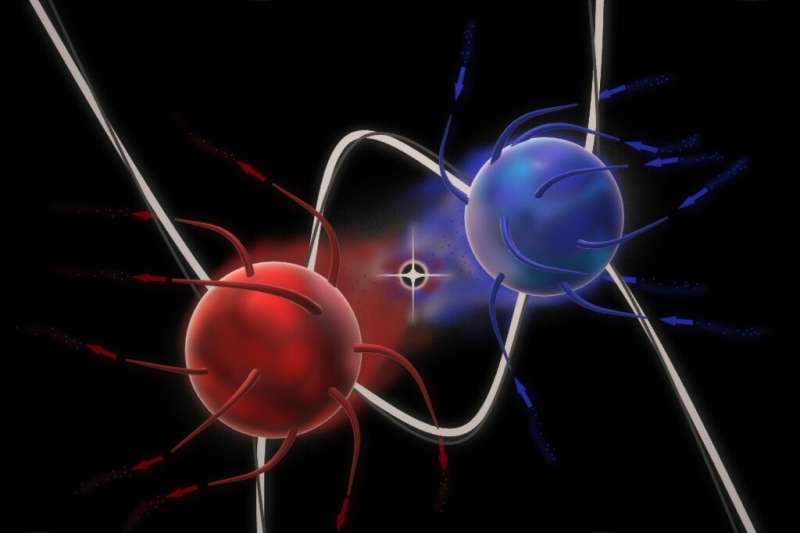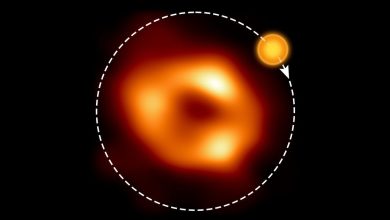
Mutual annihilation of two topological quasiparticles. Credit: Raphaël Bühler
A donut is not breakfast. They are two very clearly distinguishable objects: one has a hole, the other does not. In mathematics, the two shapes are said to be topologically different – you cannot transform one into the other by small continuous deformations. Therefore, the difference between them is robust to disturbances: even if you knead and fold the bun, it still doesn’t look like a donut.
Such topological properties also play an important role in materials science, although in a somewhat more abstract way. If a material property can be explained topologically, then it is also robust to perturbations: a change in environmental conditions does not make it disappear. Now, for the first time, a research team has succeeded in specifically switching such a topological property: some material states are stable against disturbances in a wide range of parameters, but at a certain magnetic field they can be completely switched off. This makes the topological properties of materials manipulable for the first time.
Geometry in abstract spaces
In physics, the “topological properties” of a material have nothing to do with its geometric shape – they are not samples of donut-shaped or spherical crystals. On the contrary, the term “topological properties” refers to the complex interaction of the many electrons in the material.
This interaction can be represented mathematically in a very specific way. It is often useful not to think about the position of electrons, but rather about their momentum – or in other words: their position in an abstract “momentum space”. In such mathematical spaces, certain properties of the material can be studied, which can be distinguished from each other according to topological criteria – similar to donut and bun.
“Finding such topological properties is an exciting thing in itself; in 2016, the Nobel Prize in Physics was awarded for the discovery of such states,” says Professor Silke Bühler-Paschen from the Institute of Solid State Physics at TU Vienna. “But we have now been able to show something completely new: we have succeeded for the first time in manipulating and even deactivating such topological states.”
Extreme topological effects on slow charge carriers
A special material consisting of cerium, bismuth and palladium was used for this purpose. Bühler-Paschen’s research group had already made several spectacular discoveries in previous years using this material. For example, they were able to highlight an exotic topological behavior of this material by precisely measuring its electrical or thermal properties.
This behavior results from the fact that the electric charge in this material moves in a particular way. In an ordinary electrically conductive material, current simply flows by individual electrons moving through the material. In this special material, however, it is different.
The interaction of many charge carriers here creates very special “quasiparticles” – a collective excitation of charge carriers that can propagate through material, similar to how sound can propagate through air as a density wave without individual air particles having to move from the source sound to the audio receiver.
These excitations move very slowly in this material. In a way, they don’t get along very well. And this leads to the fact that the topological properties of the material in the momentum space have particularly strong consequences in this case.
Disabling topological properties
“Our measurements show that these electrical and thermal properties are indeed robust, as one would expect from the topological properties of materials,” says Bühler-Paschen. Small impurities or external disturbances do not bring radical change. “But surprisingly, we found: with an external magnetic field, you can control these topological properties. You can even make them disappear completely at a certain point. So we have stable and robust properties that you can selectively switch on and off. .”
This control is made possible by the internal structure of the excitations, which are responsible for the transport of charges: they transport not only an electric charge, but also a magnetic moment, which allows them to pass through a magnetic field.
“If you apply an increasingly strong external magnetic field, you can imagine these charge carriers getting closer and closer until they meet and annihilate, like a particle of matter and a particle of antimatter if you let them collide,” says Silke. Bühler-Paschen.
Global search for exciting apps
The experiments were conducted at TU Wien (Vienna), but for some additional measurements the team was able to use high-field laboratories in Nijmegen (Netherlands) and Los Alamos National Laboratory (USA). Theoretical support was provided by Rice University (USA).
“This newly discovered controllability makes the topological materials that have already attracted so much attention in physics even more interesting”, is convinced Silke Bühler-Paschen.
Optionally, the switchable topological states could be used for sensor or switching technology. It is precisely because the excitations in the material are so slow and therefore of very low energy that they are particularly interesting: the excitations couple to radiation in the microwave range, which is particularly important for many applications. techniques. Entirely new and more exotic applications in electronics, including quantum computers, are also possible.
The research has been published in Nature Communication.
Designing new quantum materials on the computer
Sami Dzsaber et al, Electronic Topology Control in a Strongly Correlated Electronic System, Nature Communication (2022). DOI: 10.1038/s41467-022-33369-8
Provided by Vienna University of Technology
Quote: Topological Materials Become Switchable (October 10, 2022) Retrieved October 11, 2022 from https://phys.org/news/2022-10-topological-materials-switchable.html
This document is subject to copyright. Except for fair use for purposes of private study or research, no part may be reproduced without written permission. The content is provided for information only.
#Topological #materials #switchable






